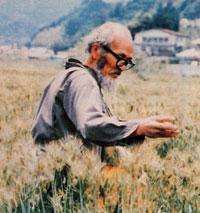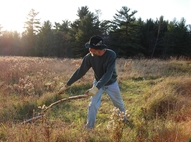 Yes, the "One Scythe Revolution" is an allusion, in part, to Masanobu Fukuoka's classic The One-Straw Revolution. Back in 1984, I attended a conference with Frances Moore Lappe, and this documentary was shown there. Up until then, my life's ambition had been to be an artist. After seeing this documentary, I was inspired to take a little detour, and become a Natural Farmer, and then do my art in all my free time, once Nature started doing most of the work. This turned out to be harder than it looks! I'm still working at it, but I think that the scythe could make Natural Farming work here in temperate climates. I hope to be writing more about that in future posts. Too much fertilizer does make grass plants grow too tall, but 5:43 the narrator is not quite correct. According to the book, Fukuoka grew a variety of rice that he specifically sought out for his farming technique. He wanted a variety that grew shorter stems, and more kernels per stalk. A variety that put more of it's energy into growing seed, instead of stalks. So it's not just the effect of not using chemical fertilizers that he gets more rice seeds per grain head. It's the variety he grew. Here's another good documentary: How's your German? Here is a beautifully filmed German documentary. "Der grosse Weg hat kein Tor". "The Great Way (Path) has no Gate". How's your Spanish? Below is a video showing a Japanese scythe in action, and how to sharpen one. Many years after I was first inspired by The One-Straw Revolution, I reread the book and realized that Fukuoka also had what I call a scythe based farm. Scythe and sickle. The scythe was used to set back and manage the succession in his forest gardens, and the sickle was used to harvest his rice fields.
0 Comments
Your comment will be posted after it is approved.
Leave a Reply. |
Botan AndersonArchives
March 2023
Categories
All
|

 RSS Feed
RSS Feed